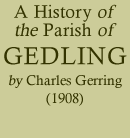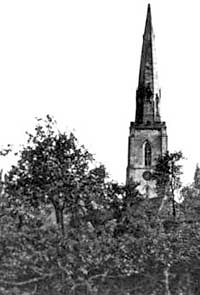< Previous | Contents | Next >
The Church.
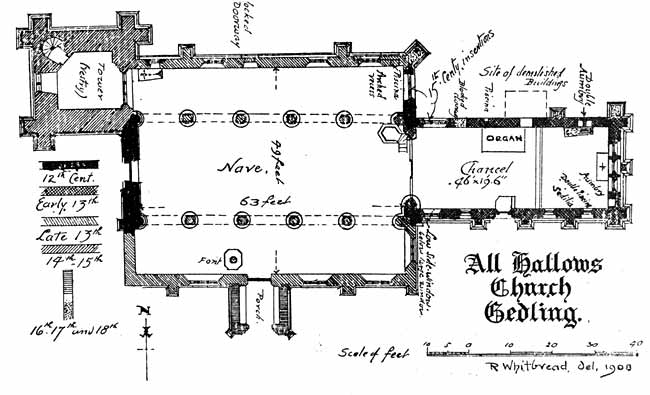
THIS beautiful building, dedicated to All Saints (All Hallows) stands at the north-west side of the village, on a slightly elevated site. Taking it collectively, the Church is an extremely interesting structure.
The component parts are a tower and spire, a nave with clerestories and side aisles, a south porch, and a chancel.
Since the erection of a Norman church, in the 11th century, very considerable alterations have taken place from time to time. It is difficult to say whether this was the earliest church built on this site or not. Its ground plan cannot now be traced. Its chief remains are in the east end of the north aisle, and consist of a rood loft doorway, now blocked up, some rubble walling, and a drip course. This church did not exist long. Another, nearly, or quite as large as the present one, was built late in the 12th century. A considerable part of the body remains.
The following are the chief parts:—Part of the west end of nave, with the responds of nave arches. A small window in the north aisle, and the south and east walls of the chancel, as high as the window sills. The doorway in the west end appears to have been the principal entrance. The head is pointed and moulded with a pear-shaped bowtell.
A moulded drip course runs round the head and abuts on the abaci. It had originally two shafts, but these are missing, the caps and a base remain. The volutes and necks of the caps are sharp and distinct in shape. The present arches of the nave belonged to this church, they are very obtuse, and were re-built on Early English octagonal piers in the 13th century. It is probable that this church was destroyed, as its magnitude and good construction would have met all ordinary requirements for centuries after its erection. The following are the dates at which the various parts were erected:—
Circa 1090. Some part of the east end of the north aisle.
Circa 1175. The lower part of the west end of the nave, small windows in north aisle, the nave arches, and the chancel walls, as high as the window sills.
Circa 1275. Two windows and some of the walling in north aisle.
Circa 1280. The whole of the south aisle.
Circa 1320. Window in the end of nave.
Circa 1330. Tower and spire.
Fifteenth century. The south porch, nave roof, and clerestory.
The present church appears to be only about the same size as its predecessor.
The chancel above the string course is Early English work, circa 1230. Few chancels of village churches have the fine, yet chaste appearance that this has. Inside, it is 46 feet in length and nearly 20 feet in width.
In the east end there is a good triple window, having in and outside filleted shafts and moulded heads. There are no drip courses to the head, a few feet above which is an elongated and widely splayed quatrefoil opening. The south wall is pierced with four narrow but long lancet windows, having outside shafts. The details of these and their heads are similar to those of the triple window. Continuous drip courses connect the heads both inside and out. The lights are not set in the centres of their respective bays, a peculiarity that might easily pass unnoticed. The Priest's doorway is in this south wall and was inserted circa 1230. It is small and has a deeply moulded head, with a drip course terminating in conventional foliage. This doorway is exceedingly fine in design, but is rapidly losing its sharpness of outline. The original entrance was more westwards, but was removed in the 13th century to make room for the two-light window in the corner. The step in the string course and the joints in the masonry, both inside and out, indicate the original entrance. The head of the two-light window is filled with soffit cusping of an uncommon and very early pattern (this is modern, but appears to be a faithful reproduction of the original). The oblong opening immediately beneath the window is what is usually called a Leper Window, and through it confessions are supposed to have been heard and alms distributed, &c. The altar in the side chapel and a founder's or benefactor's tomb in the north aisle could be seen through it. The shutter hook and catch remain.
At the inside of this south wall and near the east end is a Sedilia, inserted circa 1230, having three arches and a double Piscina of later date under one. The arches are trefoiled, deeply moulded, and enriched with the "dog-tooth" ornament. A hood moulding connects them, and terminates in carved heads. The shafts of the Piscina have been altered from their original forms; the head has no "dog's-tooth" ornament.
The north wall contains one window, which is Perpendicular in style. There are also two doorways and a double Aumbry (Almery). The wall has been re-built again and again. Outside this wall there was a side chantry or chapel. It is highly probable that some part of the Norman chancel wall formed the side wall of this Chapel or Chantry. The chapel appears to have stood until the early part of the 15th century, about which time the Perpendicular windows were inserted. A Piscina is in the outside wall, and is a plain chamfered recess, with a pointed head and a shallow basin.
"Throsby,"in his edition of "Thoroton" (1795), vol. 3. p. 15, says of the chancel, "The stalls here are handsome and the water stocks the most perfect I have seen."
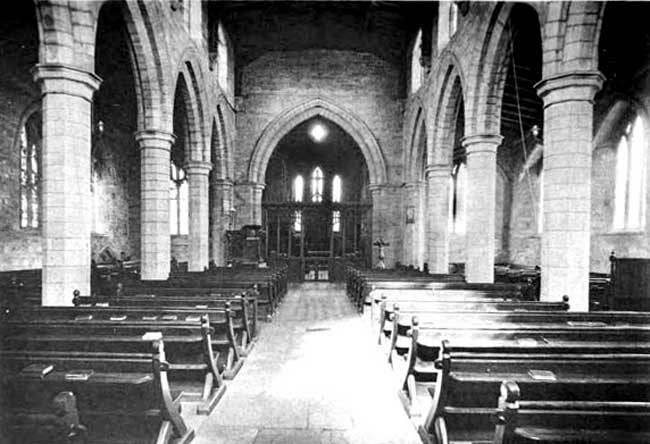 Interior, looking East.
Interior, looking East.The body of the church is spacious and is lighted by wide windows. The south aisle contains four, three of which have three-lights each, and their heads touch the enclosing arch. The fourth and westernmost is a rather uncommon one; the outer chamfer of the head is foliated somewhat after the style of the large wheel window at Peterborough Cathedral. The heads of the lights have solid cusps, and some of the spandrils are pierced ; the head is a clumsy piece of work. The drips on this side, with one exception, terminate in mask heads.
In the north aisle are two three-light Early English windows, a Perpendicular one, and a Norman transitional one. The Early English ones are similar to those in the south aisle, but narrower. The easternmost of these contains some fragments of old coloured glass, which, in Thoroton's Antiquities, 1677, are described: "Arg. on a Fesse double Cotised Gules, three Flowers de Lis of the Field, Normanvile, quartering Azure, a Chevron between three Birds Arg." The small window near the west end of this aisle is very narrow and short. It has a solid trefoiled head formed of a single stone (circa 1190). The head and jambs are widely splayed and set flush with the outside of the wall; it appears to be in its original position.
Under the easternmost window of this (north) wall is a low recess, having a pointed segmental head moulded and cusped, resting on short shafts; the caps remain almost perfect, but the bases are mutilated.
A sarcophagus, now lying near the Tower arch, was found near this spot in 1872. Up to the time the Church was restored the site was enclosed by an oak screen of Perpendicular character, part of which was removed to the Tower archway, where it still remains, and now forms the Vestry screen, doorway, &c. It is probable that this enclosure formed a founder's or benefactor's Chantry.
The east window of the north aisle is a Perpendicular one, and contains fragments of old coloured glass. The glass of this window is given in Thoroton's Antiquities, 1677, as, "Azure three Cinquefoils Or, Bardolf, quartering Azure, a Lion Ramp, and Flowers de Lis Or, Beaumont."
(Thoroton also says, that in the east window of the south aisle, "Azure, three Cinquefoils Or, Bardolf." Evidently these fragments have been destroyed).
The west end of the nave is pierced with a rather large Decorated window, of three lights, the head is filled with flowing tracery, cusped and beautifully moulded. Exteriorly the jambs are decorated with a very rich four-leaved flower. The drip courses are very bold and terminate in carved heads. On either side of the window is a niche, inserted early in the fifteenth century. On the right is an effigy very much mutilated. A corresponding effigy was accidentally broken in 1872.
The Tower, 89 feet, is surmounted by a very fine spire, and stands at the north west corner of the Church, opposite the end of the north aisle. It is Decorated work of the early part of the 14th century. The plinth is deep and beautifully moulded. The buttresses are at right angles with the walls and reach nearly to the battlements, these rise from a corbel table of grotesque heads, and are low, thin, and badly moulded. They do not appear to be anything like so old as the lower work.
The Bell chamber is lighted with four two-light pointed windows.
The Spire, 92 feet, is octagonal in plan, and connected with the Tower by squinches. It springs almost vertically from within the battlements for a few feet, and then gradually diminishes to the apex, which carries a gilded weathercock. The "entasis" (swell) is very bold, and when seen from a distance has a very elegant appearance. The angles are moulded with a large round and hollow, running up to within a few feet of the apex. After a careful examination of the work at the base of the Spire, it becomes clear, to any trained eye that either the original design was not strictly carried out, or the Spire and the top of the Tower were rebuilt. The very abrupt change in the angle rolls near the base; the curious finish of the stairs, the low, thin battlements, and the ill-arranged doorway leading to them are very peculiar features. Pinnacles (which are now missing) were added in the Perpendicular period.
In each of the four cardinal faces of the Spire is a niche, three of which contain effigies, the south-east one is that of a Knight in mail armour, with pointed shield and a short sword. The other two are mutilated beyond description. It may be stated (on good authority) that the entasis of this spire is one of the most perfect specimens to be found in the Kingdom.
It is said that Pugin, whilst building S. Barnabas Cathedral, Nottingham, visited Gedling Church several times, and that he was influenced in some of his works by the graceful design of the spire of Gedling Church.

It is worth while inserting here what Mr. J. C. Robinson (Nottingham, 20 February, 1844) said about Entasis (vide Civil Engineer and Architects' Journal): "In a report of a recent meeting of the Royal Institute of British Architects, given in your journal of January 27th, 1844, I observed some remarks on the question of entasis in spires, from which it appears that the gentlemen who took part in the discussion had not recognised decided curved lines in any spire except that of Newark. I am happy to be able to instance, from the same district, a much finer and better developed example than the spire of that Church, which, it is true, has a positive though slight entasis. The accompanying drawing, which is an elevation of the steeple of Gedling Church, about four miles from Nottingham, will more clearly exemplify this assertion. The scale and measurements may be depended upon, as the latter were taken during some repairs at the summit of the spire. It will be seen from this that the variation or bulging from a straight line drawn from the base to the summit is very considerable, being in the widest part not less than two feet; indeed, the swell is so great as to prevent a person upon the leads of the tower seeing the weathercock, unless by leaning over the battlement; the curves extend 43 feet from the top of the battlement, where it meets the straight lines of the rest of the spire, and forms the segment of a circle whose radius is about 270 feet. The style of the spire is of what I should denominate the Second Decorated, circa 1320; and it is perhaps worthy of remark that Newark is also of Decorated date, although somewhat later than Gedling. It is situated on the north-west angle of the nave, and consequently groups very picturesquely with the body of the Church, which possesses many interesting features, and has a most exquisite Early English chancel of rather unusual dimensions (50 ft. by 25 ft.). There are four niches occupying the alternate faces of the spire, as indicated in the drawing; they contain male and female statues, in the attitude of prayer. One of the best preserved figures is apparently clad in chain mail, with a low conical helmet, and wears either a jupon or cyclas, with a triangular or heater-shaped shield, and a sword girt upon the thigh; this costume corresponds with the date to which I have assigned the erection of the steeple."
The Tower contains four bells, bearing the following inscriptions.
No. 1.—"God save His Church. 1595."
No. 2.—"God save His Church. 1722."
R. Wood, Rector. I. Rose, Warden.
No. 3.—"Unto our God most high be prayse continualie. 1617."
No. 4.—"All you that hear my mournful sound, Repent before you lye in ground."
T. Brierley, C. Martin, R. Jarman, Churchwardens. Founder, Thos. Hedderley. 1759.
The inscription on No. 4 appears to be a variation on that of many bells in the district, one of which is as follows:—
On the oak bell frame is this inscription:—
The tower also contains a clock with four dials and quarter jacks, put up in 1879 by private subscription.
The four bells were recast in 1902, when the date, with the names of the Rector, A. E. Bertie, and Churchwardens, R. Butler and A. C. Wainwright, now appearing on the bells, were added to the inscriptions. The cost was defrayed by public subscription.

The Porch.
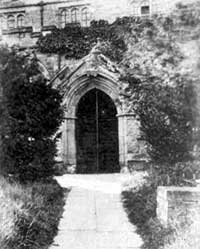
The Porch after the accident.
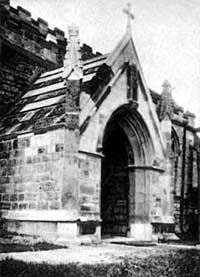
The Porch restored.
The Porch is on the south side of the Church. It is Perpendicular work (late 15th century) with a good pointed waggon-vaulted stone roof, lower in pitch than its predecessor, the drip course of which still remains in the wall above. The gable has a central canopied niche, tenantless; at the bottom of it are three blank shields. About 1860, the greater part of the head of a Cross was unearthed in the garden of the "Chesterfield Arms," Gedling. Though somewhat mutilated, there are distinct traces of the Crucifix on one side, and the Blessed Virgin and Child on the other. It is of Mansfield stone, and, judging from its few characteristics, it is a Fifteenth Century production, and may be some of the remains of the Porch Cross. It was presented to the Church by the late Mrs. Cheshire, of Gedling, and has been mounted on pivots, on the south wall of the Vestry.
The buttresses of the porch are set diagonalwise, and are surmounted by crocketed pinnacles. The south-west one is the smaller of the two, and probably belonged to the nave or aisle embattlements. The nave and south aisle have embattlements, and formerly had pinnacles similar to those on Bottesford Church; the bases and gurgoyles still remain. One of these gurgoyles is very grotesque and is shewn in Throsby's edition of Thoroton, 1795, Vol. 3, plate at page 30, figure 7.
A thorough restoration of the porch, at a cost of £80, was recommended by Sir Arthur Blornfield, the eminent architect, in the year 1889, but unfortunately the projected work was left in abeyance. Since that date the ivy which so picturesquely surmounted the roof increased its roots and became possessed of every available crevice. This growth caused a gradual tilting and consequent dislodgment of a considerable quantity of masonry, a condition which caused much anxiety to the more observant parishioners. The climax was reached early in the Spring of the present year (1908), when the ivy again commenced its annual growth, and the apex of the gable fell in one Sunday morning in June, after service, when, fortunately, no one was very near. Restoration being now imperative, the necessary work was carried out in August and September, under the direction of Messrs. Blomfield & Sons, of London, Architects, by Messrs. Thompson & Son, Builders, of Peterborough. The total cost of the work was £160. In the re-setting of the stonework of the roof the old pitch has been abandoned in favour of a steeper one. This has destroyed the congruity of the old work with which one had so long been familiar. The new pitch follows very closely to the lines of a pre-existing weather-moulding in the wall of the south aisle, upon which the porch abuts. This moulding, by which the "battle of pitches" was settled, however, appears to have belonged to a porch which was not only larger but of a much earlier date than that to which the present porch could be assigned.
The clerestory and the nave roof were added in the 15th century, and was a fair specimen of village church roofs of the Perpendicular style. The main timbers were moulded, and most of the intersections were covered with carved patterae. Only five remained in 1886. No. 1 bad carved foliage; No. 2, four faces, two of which were in the act of blowing trumpets; No. 3, a squirrel; No. 4, a winged lion, passant guardant, and holding in the sinister paw a kind of bow; and No. 5, a griffin.
The roof was restored in 1889.
